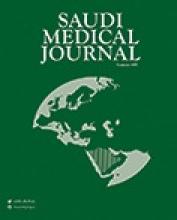Abstract
OBJECTIVE: To report the initial evaluation of the linguistic and psychometric validation of the Nepean Dyspepsia Index (NDI), as part of the ongoing research of quality of life among dyspeptic patients.
METHODS: The Arabic version of the NDI was administered to 158 subjects (54 with non-ulcer dyspeptic [NUD]), 50 with gastro-esophageal reflux disease (GERD) and 54 with no history of gastroenteritis disease), with a mean age of 46.6 and SD 10.7. All subjects answered the Arabic versions of the General Health Questionnaire (GHQ), the Self-Report Questionnaire (SRQ), and the Short Form-12 Quality of Life (QOL) scale. We administered the final translation of the NDI by consensus. The study was conducted in King Fahad Hospital of the University, Al-Khobar, Saudi Arabia, between December 2002 and January 2004.
RESULTS: The NDI has shown adequate internal consistency. Cronbach Alpha coefficient ranged between 0.88 to 0.93, and Split-half correlation reliability ranged between 0.82 and 0.94. Correlations between NDI subscales and total scores were high and significant. Adequate Face and content validity was demonstrated by consultation with gastroenterologists and clinical psychologists. Convergent validity was shown in the moderate and significant correlation of the NDI subscales and global index with the indices of the SF-12. Divergent validity was shown in that subscales of the NDI revealed low correlation with scales which measure other dimensions; thus, both QOL subscales and symptom checklist have discriminated patients from non-patients groups (p>0.01). The factorial structure of the NDI was also examined, and it revealed 4 factors, which is similarly the same with other studies.
CONCLUSION: The initial validation of the Arabic version of the NDI has shown that this scale has adequate psychometric and linguistic property and can represent a good addition to health outcome measures in dyspepsia research. Further validation studies are recommended.
- Copyright: © Saudi Medical Journal
This is an open-access article distributed under the terms of the Creative Commons Attribution-Noncommercial License (CC BY-NC), which permits unrestricted use, distribution, and reproduction in any medium, provided the original work is properly cited.






